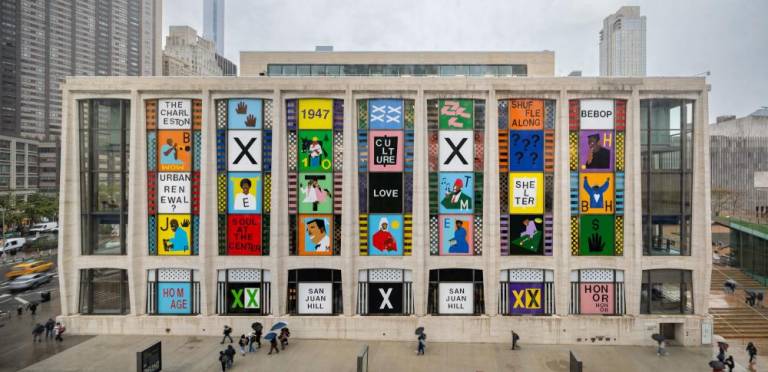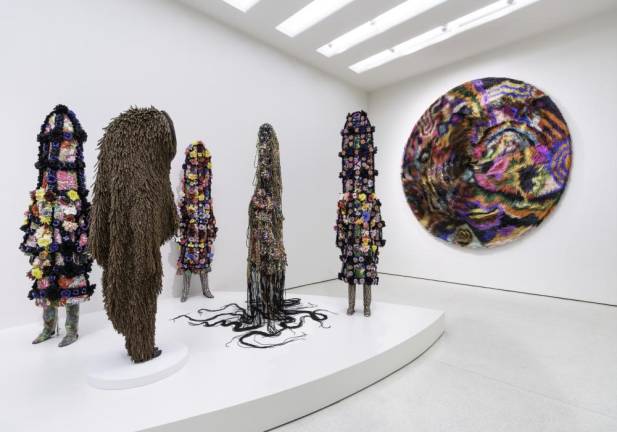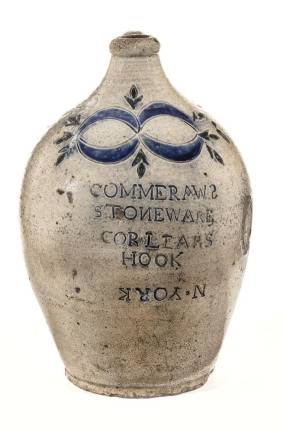Major Museums Feature Things to Do in Black History Month That Often Last Beyond Feb.
From the Guggenheim and Lincoln to the Met and the Africa Center, there’s plenty to see and view as the biggest museums in the city put on shows that often stretch past the one month of the year dedicated to Black History.
By Mary Gregory
February, Black History Month, offers countless ways to celebrate the immense contributions of Black creators, including these exhibitions. Prepare to be enriched and inspired.
Nina Chanel Abney’s San Juan Heal exhibit David Geffen Hall façade, Lincoln Center
For an extraordinary intersection of contemporary art, local history and Black creativity, head over to Lincoln Center for a truly monumental work (150 feet long) by New York artist, Nina Chanel Abney. Abney’s bright, bold imagery covering the newly refurbished David Geffen Hall pays homage to San Juan Hill, the largely Black neighborhood that was razed in the 1940s to make way for what has become the Lincoln Center campus. With words, colors, patterns and figures Abney paints a loving, joyous portrait celebrating the rich cultural impact of past residents like musicians Thelonious Monk, Benny Carter, and James P. Johnson and pioneers like Barbara Hillary, the first African American woman to travel to both the North and South Poles. Interwoven are questions about urban renewal and shelter. “San Juan Heal” along with Jacolby Satterwhite’s “An Eclectic Dance to the Music of Time” were commissioned by Lincoln Center for the Performing Arts in collaboration with The Studio Museum in Harlem and Public Art Fund.
10 Lincoln Center Plaza, publicartfund.org
The New York Historical Society Museum & Library
“Crafting Freedom” traces the story, art and legacy of Thomas W. Commeraw, a free Black man who was born enslaved, but went on to build a successful New York pottery business. With some 20 ceramic pots, along with newspaper clippings and other documentation, a story emerges of a remarkable entrepreneur and artisan, and a dynamic, engaged citizen.
Kara Walker utilizes a somewhat antiquated art form, the silhouette, to tell challenging, urgent, and instantly recognizable narratives built on history. This series of 15 prints considers the stories of African Americans that were told, untold, or suppressed in an 1866 anthology, “Harper’s Pictorial History of the Civil War.”
Crafting Freedom: The Life and Legacy of Free Black Potter Thomas W. Commeraw Through May 28; Kara Walker: Harper’s Pictorial History of the Civil War (Annotated) Feb. 24 - June 11
170 Central Park West, nyhistory.org
Nick Cave: Forothermore Through April 10, Guggenheim Museum
Forothermore (it’s easier if you read it as For Other More) is a retrospective covering the entirety of Nick Cave’s career, including several of his beloved “Soundsuits.” Part sculpture, part costume, all extraordinary, they’re multimedia works that flutter, jangle, sparkle and move, and they’re also incredibly moving. These utterly original works, wearable worlds of globes and birds, wires and gems bring delight to audiences, but have a somber origin. The first was made in 1992 as a response to the beating of Rodney King. It was crafted of twigs and sticks as a kind of armor and disguise, both concealing and transforming Cave’s identity. “I could be whoever I needed to be and be confident,” he has stated. Cave credits his quilting grandmother and his furniture making grandfather for stirring his creativity. “Style was everything, and that’s all part of a spiritual identity of self.”
1071 5th Ave, guggenheim.org
Fictions of Emancipation: Through March 5, The Met Fifth Avenue
Within this exhibition built around “Why Born Enslaved,” a masterful work by French sculptor Jean-Baptiste Carpeaux, is the opportunity to view Edmonia Lewis’s “Forever Free.” Lewis was a 19th century sculptor of African American and Ojibwe heritage. She so excelled in sculpture that she gained international recognition and worked in European capitals, eventually settling in Rome, where this sculpture was made. In addition to sculpting portraits of abolitionists she admired, she chiseled this powerful work in marble depicting a standing man who’d broken his shackles and raises his arm proclaiming his freedom. “I was practically driven to Rome in order to obtain the opportunities for art and culture, and to find a social atmosphere where I was not constantly reminded of my color. The land of liberty had no room for a colored sculptor,” she noted.
1000 5th Ave, metmuseum.org
States of Becoming Through Feb. 26, The Africa Center
With works from 17 contemporary artists from Ghana, Ivory Coast, Kenya, Liberia, Mauritania, Nigeria, Senegal, Sierra Leone, Sudan, Trinidad and Tobago, Tunisia, and Zimbabwe who have worked in the United States over the past 30 years, the exhibition deals with individual responses to movement, resettlement, and local and global realities and concerns. Belonging, estrangement, identity, race and hybrid cultures all find voice in striking works of art.
1280 Fifth Avenue, theafricacenter.org
The Harlem Fine Arts Show Feb. 24 – 26, The Glasshouse Midtown
The Harlem Fine Arts Show hosts its 15th annual presentation from Feb. 24 – 26. It’s a chance to see the work of American and African artists from around the world, young and old, professional and students, established and just breaking out, in painting, sculpture, photography and more. They’re all in one exhibition at The Glasshouse Midtown.
660 12th Ave, hfas.org


